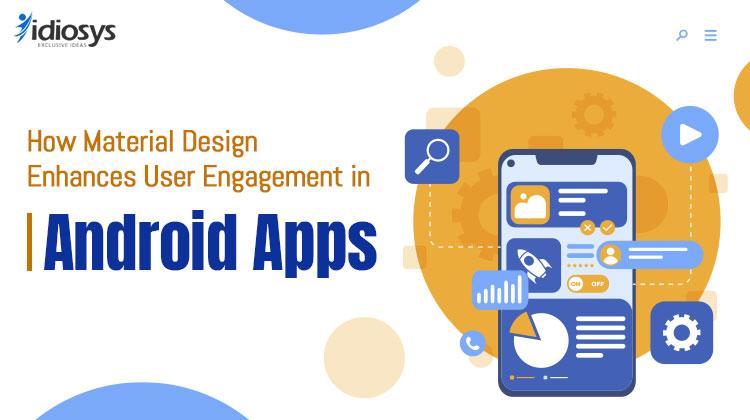
How Material Design Enhances User Engagement in Android Apps
Engaging users with your app is essential in the current mobile market. Your app’s success depends on user engagement, which affects various factors such as downloads, reviews, in-app purchases, and brand loyalty. As an app developer or a mobile app development company, you need to know how to create a captivating user experience (UX). Fortunately, Material Design provides an effective way to do so.
What is Material Design?
Developed by Google, Material Design is a comprehensive design language specifically built for Android apps. It provides a set of guidelines that promote consistency, intuitiveness, and visual appeal, ultimately leading to a more engaging user experience.
Benefits of Material Design for User Engagement:
- Intuitive and Familiar: Material Design adheres to established user interaction patterns familiar to Android users. This intuitive experience minimizes the learning curve, allowing users to navigate the app with ease, leading to increased satisfaction and reduced frustration.
- Visually Appealing: Material Design emphasizes clean layouts, bold colors, and subtle animations. This creates a visually engaging experience that captures user attention and motivates them to explore further. Imagine a well-designed app with clear hierarchy, vibrant colors, and smooth transitions. This not only makes the app aesthetically pleasing but also subconsciously influences users to spend more time interacting with it.
- Accessibility and Inclusivity: Material Design prioritizes accessibility by ensuring the app interface is usable for people with disabilities. This includes features like high contrast themes, clear text hierarchy, and touch target sizing, making your app more inclusive and reaching a wider audience. In today’s diverse world, fostering inclusivity is not just an ethical responsibility but also a smart business decision.
- Increased Efficiency: Material Design components, like navigation drawers, floating action buttons, and bottom app bars, are designed to optimize user interactions. These intuitive elements allow users to find what they need quickly and efficiently, minimizing the time and effort required to complete tasks. This streamlines the user experience, keeping them engaged and focused on achieving their goals within the app.
- Brand Consistency: Material Design allows for a high degree of customization while maintaining core design principles. This empowers app developers in London and worldwide to integrate their brand identity within the framework. Through the use of specific color palettes, typography, and iconography, developers can create a unique and recognizable app experience that aligns with their brand image, fostering brand recognition and loyalty.
Enhancing User Engagement with Material Design:
- Leverage the Power of Motion: Material Design encourages the use of subtle animations to highlight actions, guide user attention, and communicate changes within the app. These animations can add a layer of polish and interactivity, making the experience more engaging and enjoyable.
- Embrace Dynamic Theming: Allow users to personalize their app experience by offering light and dark themes or even the ability to choose accent colors. This level of customization empowers users and creates a sense of ownership, fostering deeper engagement.
- Prioritize Content Hierarchy: Employ Material Design’s layout principles to organize and present information clearly. Utilize cards, grids, and proper spacing to create a visual hierarchy that guides users towards the most important information and functionalities. This enhances clarity and simplifies user flow, making navigation and interaction intuitive and engaging.
- Maintain Consistency: Ensure consistency throughout the app by adhering to Material Design guidelines. This includes consistent use of colors, fonts, icons, and layout patterns. Consistency creates a sense of familiarity and reduces cognitive load, making users feel comfortable and confident using the app.
- Consider Material Design : The latest iteration, Material Design 3, introduces new features such as dynamic color, adaptable UI components, and a focus on storytelling. By incorporating these elements, app developers can create a more modern, expressive, and engaging user experience.
Why Choose Project-Wise Hiring or Dedicated Development Teams?
At Idiosys UK, we understand the importance of aligning your app’s design with user expectations. Whether you are an IT company in London looking for collaborative partners or a tech individual seeking an app developer in London or elsewhere, we offer both project-wise hiring and dedicated development teams to cater to your specific needs.
Our team of experienced mobile app developers possesses in-depth knowledge of Material Design principles and can help you create an app that not only meets your business goals but also fosters exceptional user engagement. We are committed to providing customized solutions that seamlessly integrate Material Design into your app, propelling it towards success.
_________________________________________________________
How does Material Design enhance user engagement?
Material Design enhances user engagement by providing a visually appealing and consistent interface, making it easier for users to navigate and interact with the app.
Why is consistency important in Material Design?
Consistency helps users predict the behavior of the app, reducing the learning curve and enhancing overall user satisfaction.
Can Material Design be customized?
Yes, while it provides a framework, developers can customize colors, shapes, and other elements to align with their brand identity.
How does Material Design enhance brand identity?
It allows customization while maintaining consistency, enabling brands to express their unique identity within a familiar framework.
What is Material Theming?
Material Theming allows developers to customize Material Design to reflect their brand’s unique style through colors, typography, and shapes.
What is the impact of Material Design on app development time?
Using standardized components and guidelines can speed up development time by providing clear direction and reusable elements.
What is the future of Material Design?
The future of Material Design includes continuous improvements and updates to align with evolving user needs and technological advancements, ensuring it remains a leading design framework.
_________________________________________________________
You May Also Read
Elevate Your Real Estate: Why Your Business Needs a Custom Application
How a food delivery app can transform your restaurant business in 2023

